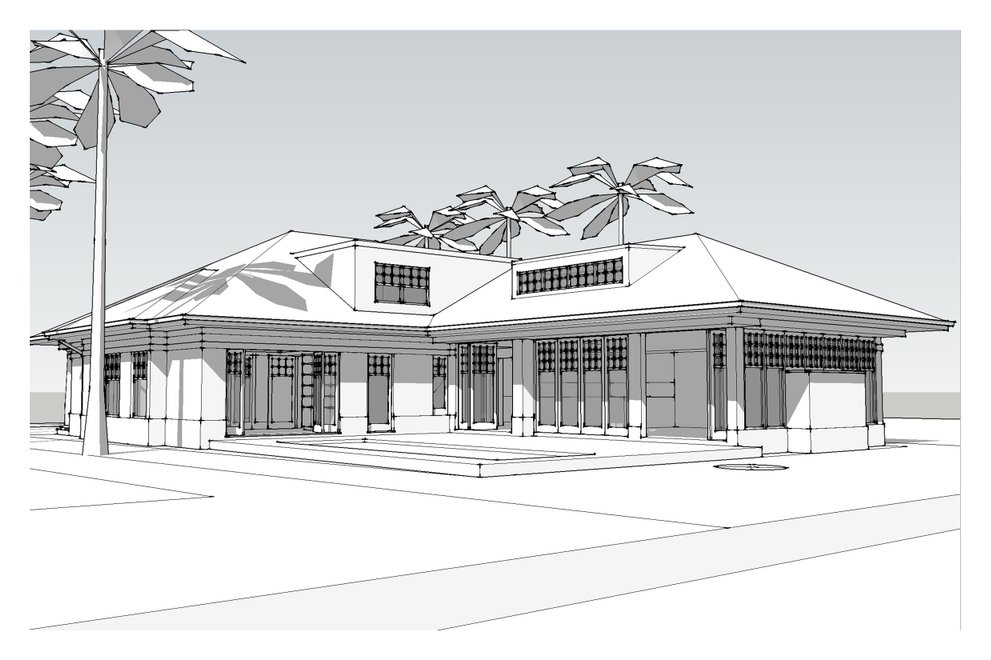Architectural drawings can be difficult to comprehend. This is simply because they are two dimensional
representations of a home’s parts. So let’s look at the most common
drawings to see how each is read, understood and used.
Site plan.
Plan 547-1 by Prairie Wind Architecture. The site plan shows how the footprint of the home will sit on the land -- the contour lines you see here indicate the slope: closer together mean it's steeper; farther apart: flatter. This type of drawing is important as a way to reveal orientation to landscape or lot features, to the sun and wind, and to outdoor living space.
Computer aided drawing (CAD).These systems have made it easier to generate perspectives and other 3D views.
(Plan 481-4 by Bud Dietrich) These drawings are useful in helping you “walk through” the home before it’s constructed and visualize how interior rooms relate to each other. These drawings can also help you visualize the exterior. In fact, there are times when the drawing is so realistic that you don’t know if you’re looking at a photo or a drawing,as in the example below (a computer drawing).
(Plan 888-8 by Nicholas Lee)
The floor plan. It identifies each room and indicates the locations for walls, doors, windows, stairs, cabinets, appliances, plumbing fixtures, electrical devices and furniture. The rooms are labeled so we know where each functional area is in relationship to another room.
(Design by Gregory La Vardera) And we'll be able to see how we can get from room to room. Because windows and doors are shown, we can see how each room relates to the others. For example, we'll be able to see if doors and windows are aligned to create view corridors. You can learn more about how to read a floor plan here.
Exterior elevations. These are next most common drawings.
(Sea Ranch Cottage Plan 447-3 by William Turnbull) These drawings are two dimensional representations of what the exterior of the house will look like. What materials are used, roof heights, window and door locations as well as the roof shape are all indicated. But as you look at an exterior elevation remember that you’ll never actually see the house like it’s drawn. So while these are essential drawings to communicate the design intent, you’ll get a much better feel for the exterior viewing a 3D drawing such as a perspective.
(Flexahouse Plan by Nick Noyes)
Building section. An often overlooked yet very important drawing.
(Plan 481-1 by Bud Dietrich) This drawing, like a typical floor plan, shows a slice through the house. But this time the slice is vertical instead of horizontal. A section is important because, as we read the drawings, a section gives us an understanding of the home’s spatial qualities. Sections answer questions about ceiling heights and shapes, window and door sizes and locations, structure and materials and more. Sections are so important to the overall spatial quality of the house that I, like many other architects, spend quite a bit of time designing in section.
Detail Drawings. This the last type of drawing that goes into a complete set.
(Design by Bud Dietrich)
The purpose of detail drawings is to show all of the details that go into the making of a home. How walls meet floors, exterior soffits meet roof overhangs and so much more are all part of the details that should be drawn. Without these, much of the construction is left to chance. As that famous architect Mies Van der Rohe so accurately put it, “God is in the details.”
To see the house by Bud Dietrich illustrated at the top of this post, click on Plan 481-4.
To see all of Bud's designs, click here.
Site plan.
Plan 547-1 by Prairie Wind Architecture. The site plan shows how the footprint of the home will sit on the land -- the contour lines you see here indicate the slope: closer together mean it's steeper; farther apart: flatter. This type of drawing is important as a way to reveal orientation to landscape or lot features, to the sun and wind, and to outdoor living space.
Computer aided drawing (CAD).These systems have made it easier to generate perspectives and other 3D views.
(Plan 481-4 by Bud Dietrich) These drawings are useful in helping you “walk through” the home before it’s constructed and visualize how interior rooms relate to each other. These drawings can also help you visualize the exterior. In fact, there are times when the drawing is so realistic that you don’t know if you’re looking at a photo or a drawing,as in the example below (a computer drawing).
(Plan 888-8 by Nicholas Lee)
The floor plan. It identifies each room and indicates the locations for walls, doors, windows, stairs, cabinets, appliances, plumbing fixtures, electrical devices and furniture. The rooms are labeled so we know where each functional area is in relationship to another room.
(Design by Gregory La Vardera) And we'll be able to see how we can get from room to room. Because windows and doors are shown, we can see how each room relates to the others. For example, we'll be able to see if doors and windows are aligned to create view corridors. You can learn more about how to read a floor plan here.
Exterior elevations. These are next most common drawings.
(Sea Ranch Cottage Plan 447-3 by William Turnbull) These drawings are two dimensional representations of what the exterior of the house will look like. What materials are used, roof heights, window and door locations as well as the roof shape are all indicated. But as you look at an exterior elevation remember that you’ll never actually see the house like it’s drawn. So while these are essential drawings to communicate the design intent, you’ll get a much better feel for the exterior viewing a 3D drawing such as a perspective.
(Flexahouse Plan by Nick Noyes)
Building section. An often overlooked yet very important drawing.
(Plan 481-1 by Bud Dietrich) This drawing, like a typical floor plan, shows a slice through the house. But this time the slice is vertical instead of horizontal. A section is important because, as we read the drawings, a section gives us an understanding of the home’s spatial qualities. Sections answer questions about ceiling heights and shapes, window and door sizes and locations, structure and materials and more. Sections are so important to the overall spatial quality of the house that I, like many other architects, spend quite a bit of time designing in section.
Detail Drawings. This the last type of drawing that goes into a complete set.
(Design by Bud Dietrich)
The purpose of detail drawings is to show all of the details that go into the making of a home. How walls meet floors, exterior soffits meet roof overhangs and so much more are all part of the details that should be drawn. Without these, much of the construction is left to chance. As that famous architect Mies Van der Rohe so accurately put it, “God is in the details.”
To see the house by Bud Dietrich illustrated at the top of this post, click on Plan 481-4.
To see all of Bud's designs, click here.






